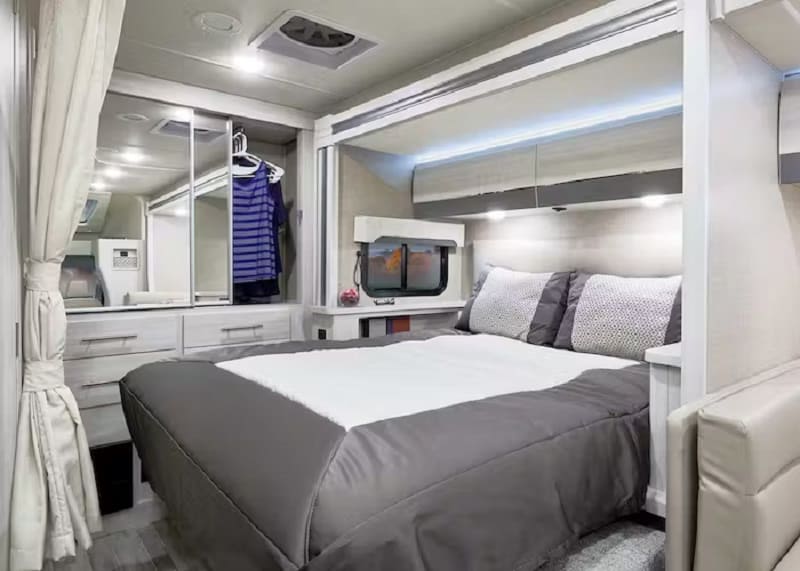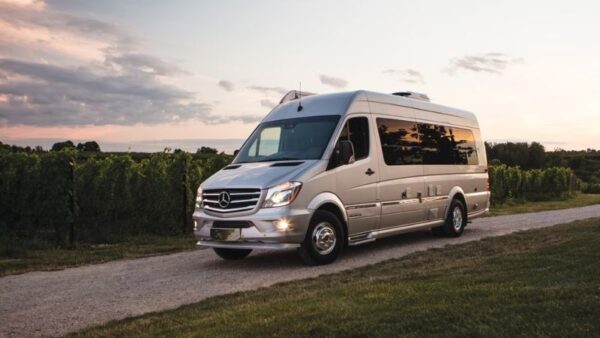Thanks for your support! If you make a purchase using our links in this article, we may make a commission. And, as an Amazon Associate, I earn from qualifying purchases. See the full disclosure here.
If you’re in the market for a compact Class B motorhome, you might have asked yourself, do Class B motorhomes have slide-outs? Since we tour and review hundreds of RVs each year, we can answer that very question in this article. Let’s go in-depth on Class B slide-outs.
RV makers have several tools in their toolkit to help maximize the limited space inside a motorhome. One of the most powerful tools at their disposal is the classic slide-out.
These expandable sections of your RV retract so you can safely navigate the highway, then extend to massively increase your living space.
It’s not uncommon for Class A and Class C motorhomes to have slide-outs and many have multiple sides. Class B motorhomes, however, are much smaller so slide-outs are actually pretty rare.
What Is A Class B Motorhome?
Before we get to the topic of Class B slide-outs, let’s talk about what a Class B motorhome actually is.
In case you don’t know already, there are three main classes of motorhome: A, B, and C. A bit unintuitively, the smallest size of the three is the Class B motorhome.
Class B RVs, in addition to their small size, are defined by being built primarily on van chassis rather than bus or truck chassis like Class As and Cs. Due to this, Class B motorhomes are commonly referred to as “camper vans.”
A variety of vans chassis are used to make Class B motorhomes, but the most common (at least in North America) are the Mercedes Benz Sprinter, Ram Promaster, and Ford Transit.
Do Class B Motorhomes Come With Slide Outs?
So, now we come to our main question: do Class B motorhomes come with slideouts?
Simply put, not usually. The vast majority of Class B motorhomes do not come with slide-outs. However, that doesn’t mean there are no Class B motorhomes with slide-outs.
In fact, there are a few options presently on the market, although most of them are larger Class B+ motorhomes with more space for a slide-out.
As demand continues to grow for Class Bs with more space, we’ll likely see more Class Bs with slide-outs hitting the market in the coming years.
Why Do Most Class B Motorhomes Not Have Slide-outs?
Class A and C RVs commonly feature slide-outs, so why don’t class Bs?
A big part of it is the build process. For example, a Class C basically puts a big rectangular box on a truck frame, and this makes it much easier to modify. Similarly, the spacious bodies of Class As make fitting in a slide-out easy.
Compare this to Class B motorhomes, which have two main barriers to installing slide-outs:
- The small size of most Class B motorhomes makes fitting a slide out (and its required machinery) into a build problematic.
- Class B RVs are most commonly built into an existing cargo van body, which makes installing a slide much harder.
While it’s possible to integrate a slide out into a Class B build, it’s a more challenging prospect than with other classes of RV. Because of this, most Class B motorhomes on the market forgo a slide-out.
Why Are Class B Motorhomes So Expensive?
If you’ve gone shopping for Class B motorhomes, you might have been surprised at their price points, ranging from around $60,000 to as much as $300,000 or more. Just why are these motorhomes so expensive, especially considering their small size?
Part of it is the build process. Class B motorhomes have a more labor-intensive build process and are often customized and built bespoke to the owner’s specifications. Due to this, Class B RV costs can get pretty high.
On top of this, many Class B motorhomes are luxurious models targeting a higher-income demographic. Retired seniors, professional couples looking for a higher-end smaller rig, and other customers willing to shell out for a nice Class B are among the main target demographic for these RVs.
The final aspect of this is supply and demand. While the increase in popularity of “van life” has increased demand for all RVs, most of the attention has gone to Class Bs. This has placed a strain on the supply of vans, leading to price increases and making the used market much more competitive.
What’s The Difference Between Class B And B+ Motorhomes?
We’ve mentioned previously that there are both Class B RVs and Class B+ RVs, but what exactly is the difference between them? Well, for one, Class B+ RVs are bigger than standard Class Bs, but this is only part of the distinction.
A standard Class B RV uses a van platform, and in nearly all cases, a Class B RV will put everything inside the original van body, and if the space is expanded, it’s typically upward using a pop-up roof. They’ll usually be 16’ to 21’ long and will be a standard van width (around 7’ max).
Class B+ motorhomes, meanwhile, are also often based on a van platform, but may also use a truck chassis. Instead of using the existing van body, they add a larger body to the chassis to increase space. They can be up to 25’ long, wider than normal Class Bs, and have a small over-cab area (but not as large of one as a Class C).
3 Class B Motorhomes With Slide-Outs You Might Like
Now that we’ve gone in-depth on Class B slide-outs, let’s take a closer look at 3 great Class B motorhomes with slide-outs
1. Airstream Atlas
Our Pros and Cons
✅ Airstream quality
⛔ Airstream + Mercedes = Expensive
- Length: 24’ 9”
- Engine: Mercedes-Benz® 2.0L 4-Cylinder High Output Diesel
- Chassis: Mercedes-Benz® Sprinter 4500 Chassis
- GVWR: 12,125 lbs
- Tow Capacity: up to 4,000 lbs
- Sleep: 2
Airstream is best known for its iconic towable RVs, but its line of motorhomes has the same exacting quality as their more famous cousins.
Based on a Mercedes Benz Sprinter, the Airstream Atlas is a Class B with a slide-out that’s also packed with other luxurious features. The slide-out provides a spacious living area toward the front of the RV that converts to the bedroom when it’s time for bed.
In the living area, you’ll find a reclining sofa for daytime, a Murphy bed for nighttime, and a media cabinet. Inside the media cabinet is a hidden 40” Samsung LED smart TV which rises out of the cabinet via remote control.
Just off the living area, you’ll find the kitchen. It features a 2 burner gas stove, a Kohler sink and faucet, a convection microwave, a slide-out pantry, and a fridge/freezer.
At the rear of the van, you’ll find a spacious residential-style bathroom. It features a walk-in shower, as well as a storage closet.
2. Leisure Vans Unity
Our Pros and Cons
✅ Beautiful interior
⛔ No AWD option
- Length: 25’ 1”
- Engine: 3.0-L V6 Turbo Diesel
- Chassis: Mercedes Benz Sprinter 3500 Dual Rear Wheel Chassis
- GVWR: 11,030 lbs
- Sleep: 2
The Leisure Van Unity is a Class B with slide-outs that boast chic design and great features.
The Murphy Lounge floorplan offers a slide-out with dual reclining chairs, a dinette table system, and a panoramic window. Then, at night, a king-size Murphy bed pulls out for a restful night’s sleep.
The kitchen features a 2 burner stove, fridge, integrated cubby system, and pull-out pantry. In the rear, you’ll find a spacious lavatory with a corner shower and skylight. Throughout the van, you’ll find chic decor and a generous 45 cu. ft. of total storage.
Other great features include ducted AC, a 40” smart TV with a sound bar and subwoofer, and LED accent lighting throughout. There are tons of great optional features available too, like an exterior TV, an integrated exterior table, a lithium battery package, and more.
3. Thor Gemini 23TE

Our Pros and Cons
✅ AWD at a great price
⛔ Limited storage space
- Length: 23’7”
- Engine: 3.5L V6 Eco Boost® Turbo Gas Engine
- Chassis: Ford® Transit AWD
- GVWR: 11,000 lbs
- Tow Capacity: 4,000 lbs
- Sleep: 2
With a spacious body and all-wheel drive, the Thor Gemini 23TE is a class B with a slide-out that’s made for adventure.
The van’s interior features a 67” sofa and removable pedestal table in the slide-out, creating ample living space. Across from the sofa is a retractable 32” TV for entertainment, and a skylight in the overhang provides plenty of natural light.
When it’s time for bed, a queen-sized Murphy bed folds out for a comfortable night’s sleep.
Next to the living area is the kitchen, featuring a two-burner gas stove, fridge, and convection microwave. At the rear of the van, you’ll find a spacious full bath, featuring a walk-in shower with skylight.
The Gemini 23TE’s great features are rounded out with a 100-watt solar panel, 15,000 BTU ducted AC, and a 4.0 Kw gas generator, among other great features.
Is A Class B Motorhome Right For You?
If you’re in the market for a motorhome, you may ask yourself if a Class B motorhome is right for you. The answer to this question depends on a few different factors.
As the smallest class of motorhome, Class Bs aren’t ideal for families. Instead, they’re perfect for solo campers and couples who don’t need as much space.
Compared to other larger classes of motorhomes, Class Bs are generally the easiest to drive, maneuver, and park. Some of them can even fit in a standard garage! They also tend to have a nice quality ride, and overall offer a high-end feel both driving and living in them. They also tend to have better fuel economy than other classes of RV.
Of course, Class B RVs also fetch a high price relative to their size. In many cases, it can actually be cheaper to buy a larger RV, like a Class C. But, the positive qualities of the Class B motorhome mean it’s a great choice for those willing to pay a bit extra.
3 FAQs About Class B Motorhomes
Have questions about Class B slide-outs, or Class B motorhomes as a whole? We have answers. Here are some frequently asked questions about Class B motorhomes.
1. What is the difference between a Class B and a Class C?
Class B and C RVs can look similar at a glance but are fairly different. Class B motorhomes are smaller, based on a van platform, and typically use the existing body of the van.
The B+ models are a hybrid of sorts between the two. They have a wider body that extends out from the cab and a small over-cab space similar to Class C models. At a quick glance, they can be mistaken for a small Class C.
Class C motorhomes place a larger body on a van or truck chassis, and have a sizeable overhang over the cab.
2. Are Class B motorhomes hard on fuel?
Class B motorhomes aren’t exactly what you’d call fuel-efficient, usually getting somewhere in the range of 18 to 25. But, they are the most fuel-efficient class of RV, so in comparison to Class A or C motorhomes, they’ll use less gas.
3. Are Class B motorhomes worth the price?
Whether or not a Class B motorhome is the right choice for you depends on a variety of factors. For solo campers or couples who want a small, easy-to-drive motorhome and don’t mind paying a higher price for it, Class B motorhomes are a great option.
But if you’re traveling with kids or you’re on a budget, you might want to consider a different option. A much larger Class C or even a used Class A can be found for the same price.
Final Thoughts About Class B Motorhomes With Slide-Outs
Class B motorhomes are an awesome choice for anybody interested in owning a motorhome, and it’s easy to see why they’ve become popular.
Although most of them don’t include slide-outs, there are some Class Bs with slide-outs available on the market currently, and this will likely increase in the future. If you want a Class B with slideouts, we recommend looking at the larger Class B+ motorhomes.
While Class B slide-outs aren’t common, they’re out there for those willing to look. When you find one, you’re sure to love all that extra space it provides.
Why not try it before you buy it? Class B RVs are perfect for the right person but definitely not for everyone. Renting a Class B to test it out is a smart move before making a significant financial commitment.
Here’s to a great RV trip in a Class B with plenty of room to stretch your legs!
Related Reading:
– Best Class B Motorhomes With A Dry Bath
– 3 Best Class B Floorplans With Slide-Outs
– Best Class B RVs That Sleep 4 People
– 5 Best Class B RV Manufacturers
Ryan Milejczak – Author and Part-Time RVer
Ryan Milejczak (mill-LAY-check) is a full-time freelancer writer and Florida native with a passion for RVs.
Ryan has been writing about RVing and sustainable living for the past 3 years while traveling.
Currently, he’s saving up to do his own camper van conversion, which he plans to take across the US and Mexico.
When he’s not writing, Ryan loves cooking, hiking, practicing his Spanish, and taking care of his plants (currently at 23 plants and counting!)


